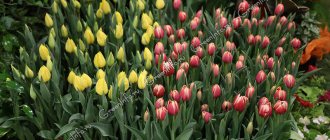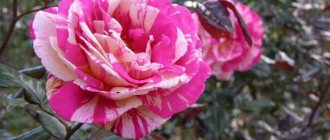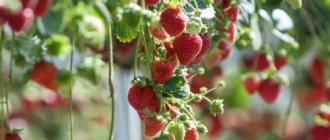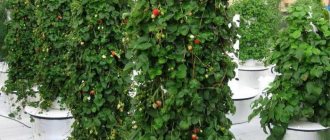The Dahlia flower is considered one of the brightest and colorful representatives of the fauna. Most gardeners are accustomed to varieties of this flower, which are distinguished by tall stems. That is why this plant is planted mainly in distant areas of the garden, so as not to cover the small flowers. But some have already become acquainted with the Dahlia Gallery variety; this is a special variety of flower that is characterized by short stature. The variety was bred in the Netherlands by gardener Gerber Verver and has a large number of varieties that differ in color and appearance.
Description of Dahlia Gallery
This varietal group includes 17 varieties. They are all relatively compact plants. The average stem height of Gallery dahlias is about 40 cm, and the flower diameter is 15 cm. These dahlias are easy to care for. They grow in almost any soil and respond well to standard fertilizers. They bloom for a long time, starting from the second half of July until the onset of the first cold weather.
Advantages and disadvantages
Gallery dahlias are beautiful flowers. But they also have not only positive, but also negative aspects.
The advantages of dahlia Gallery include:
- ease of care;
- strong immunity to diseases and pests;
- ability to grow in different types of soil;
- stability of the stems (they do not need to be tied up).
Regarding the disadvantages of this variety, Gallery dahlias really do not like stagnant water. You need to be as careful as possible with watering. Excessive moisture causes bushes to quickly rot.
Important! Only a bright place, protected from strong winds, is suitable for planting. Gallery dahlias do not tolerate frost
Peculiarities
Dahlias are recognized as one of the most spectacular flowers, which are used for landscape design, decorating front gardens, and also for making bouquet arrangements. Most of the varieties of this crop are represented by plants with tall stems. However, dahlias "Gallery" are a special species, the distinctive feature of which is the short stature of the bushes. The culture was bred in the Netherlands; today Gallery is represented by several dozen varieties.
Almost all of them do not exceed 30-45 centimeters in length, the inflorescences are lush and can be 10-15 centimeters in diameter. This variety is notable for its unpretentiousness in terms of care and cultivation, as well as a wide selection of flower colors. A large number of varieties of this low-growing flowering bush allows you to create incredibly beautiful compositions on your dahlia plot, even with minimal gardening experience.
The inflorescences of dahlias "Gallery" are a double type, collected in brushes. The stems are distinguished by their power, in light of which the crop is unlikely to be broken off by strong gusts of wind or streams of water during irrigation. The plant enters the bud development phase in the second half of May, delighting the grower with its beauty and continuous flowering until frost arrives.
Among the distinctive features of low-growing flowers, it is also necessary to note their resistance to various diseases and pest attacks. Today, seed material of this species cannot always be found on sale, but more and more gardeners prefer this particular garden crop. Among the features of the dahlia "Gallery" it is necessary to highlight the following positive characteristics:
- easy care and minimal requirements for the planting site;
- immunity to many diseases;
- the crop belongs to border flowers, so it can be grown both in open ground and in vases and pots in the fresh air;
- in the light of a powerful and small stem, the flower does not need tying or support;
- After cutting, the flower remains fresh for a very long time, even in a vase with water.
Among the disadvantages of culture, the following features should be noted:
- the plant is moisture-loving, so the gardener will need to regularly pay attention to his flower beds;
- dahlias die at sub-zero air temperatures, so the tubers must be removed from the soil for the winter.
Varieties of dahlia Gallery
Gardeners love these flowers for their beauty and wide variety of shades. Each variety brings its own unique colors to landscape design.
Dahlias Gallery Art Deco
An exquisite flower with original petals. The brick shade is interspersed with soft peach, creating a bright color. This combination visually makes the inflorescence more voluminous.
Dahlias Gallery Art Nouveau
In the middle, the petals have a dark red tint, and closer to the edges - crimson. The combination of these two tones is associated with the element of fire and symbolizes the fullness of life in all its manifestations.
Dahlias Gallery Art Fair
The smallest variety. The stem barely reaches 30 cm in length, and the flower is only 10 cm in diameter. This dahlia is completely white, with a delicate lemon center.
Dahlias Gallery Bellini
A very romantic variety. The soft combination of pink and pale yellow makes the flower look fabulous. Different types of flowers give a special charm to the inflorescence: tubular and reed.
Dahlias Gallery Valentine
A variety with large, voluminous alizarin flowers. A slight orange tint appears on the outer petals. Dahlia grows as a dense compact bush; the flower size does not exceed 9 cm.
Dahlias Gallery Singer
Dahlias are of standard height with large, double, rich scarlet flowers (diameter can reach up to 13-15 cm). The petals sit tightly in the basket and have pointed tips. The bushes branch abundantly and have feathery leaves.
Dahlias Gallery Cobra
These dahlias bring together the colors of warm summer. There are yellow and orange shades here. The subtlety and tenderness of the petals is emphasized by a clear cherry edging. The height of the stems is 45 cm. This is one of the most decorative varieties.
Dahlias Gallery La Tour
An original plant with stems and leaves of a deep green tone. A fully bloomed flower looks quite impressive. All thanks to the slightly wavy petals in pastel shades: from white to soft amethyst and lavender.
Dahlias Gallery Leonardo
Incredibly beautiful variety. Lush flowers consist of several rows of thin petals, the colors of which vary from the inside to the outside. In the depths, some of the petals are colored in shades of yellow and light green, and then salmon color predominates.
Dahlias Gallery Matisse
The colors of the petals intricately combine shades of peach and orange. Different petals are colored more or less intensely. This flower can be grown not only in a flowerbed, but also in a flowerpot.
Dahlias Gallery of Coins
Extraordinarily beautiful bushes with caps of snow-white flowers. Amazingly beautiful light purple stripes run along the petals. Each bush looks like a work of art.
Important! In closed greenhouses, tubers are planted in April. A month later you can see the long-awaited flowering.
Dahlias Gallery Pablo
About a dozen huge spherical flowers are formed on one bush. The petals are flat, narrowed at the ends. The color scheme is dominated by pastel tones: from lemon yellow to salmon. In the middle, the petals have a dark red edge. This variety has a long flowering period.
Dahlias Gallery Rembrandt
The bush of medium height is decorated with fairly large flowers of a rich pink color, their core has a creamy tint. Each inflorescence is at least 15 cm in diameter.
Dahlias Gallery Salvador
The color of this flower includes three shades: cream at the base of the petals, burgundy in the middle, and different shades of pink on the outside. The flowers are very beautiful and will stand out in any flower bed.
Dahlias Gallery Serenade
Semi-double variety with an amazing combination of warm and cool shades of yellow. The bush is literally dotted with large inflorescences. This beautiful fragile dahlia is suitable for making bouquets for special occasions.
Dahlias Gallery Cesanne
In terms of color scheme, the variety is similar to Serenade, only the tones are more saturated. And the shape of the petals is slightly different. An excellent option for decorating borders and growing in containers.
Landing Features
First of all, you need to find a suitable place. Preference is given to well-lit areas (at least 6 hours of sun per day). The soil is first thoroughly loosened and fertilized with compost.
It is best to plant dahlias in open ground after May 15th. The tubers in the hole are placed so that the eyes “look” up. They are buried into the soil to a maximum of 10 cm, and then watered thoroughly.
Attention! Leave at least 40 cm of free space between dahlia bushes. Flowers need space to grow and fully develop. The soil around the tubers can additionally be mulched with fine bark.
What you need to know about dahlias?
Dahlia (Dahlia) from the Asteraceae (Asteraceae) family is a root-tuberous perennial plant. The birthplace of culture is Mexico. In the middle zone, the vegetative period of the crop gives way to a period of rest during cold weather. But the root system of the plant is preserved, so in the spring it blooms again.
This flower is a tall shrub covered with dense leaves. Some species can reach 2.5 m in height. There are also low-growing varieties that do not exceed 30 cm.
The plants are characterized by large stems that are hollow from the inside, which makes them very fragile to break. The leaves have a dissected shape and a dark green color. The inflorescence is represented by a basket, which consists of lingual and tubular petals. Their colors may vary.
Video from the “Garden World” series:
Rules of care
Gallery dahlias need abundant and regular watering. To avoid moisture stagnation, you need to use good drainage when planting and water the plants only when the soil needs it. During the peak of summer heat and drought, the bushes are earthed up after each watering.
Fertilizers are applied no more than twice a month. Organic and mineral fertilizers must alternate and complement each other. When the buds set, drugs with a high potassium content and superphosphates are used.
Mulching has a beneficial effect on dahlias. The soil remains moist longer, and the plants themselves will be protected from pests. This method will help you resort to weeding less often.
Characteristic
Dahlia bushes of the Gallery series are compact, low-growing, from 25 to 30 cm. The height of the plants depends on the growing conditions and care. On a fertile substrate and with excess fertilizer, they can rise to 40-60 cm. But the vigorous development of green mass comes at the expense of the formation of inflorescences.
The dahlia baskets of this series are all terry, with a diameter of 10-15 cm.
The stems and peduncles are low but powerful and can withstand the pressure of wind and rain. Plants are adapted to cool, rainy weather. A prerequisite for flowering is good lighting. Baskets of flowers open under favorable conditions from the end of May, more often in June, and bloom in abundance throughout the warm season until the onset of cold weather. The flowers are not single, but collected in racemes.
Representatives of the series are attractive due to their ease of care, unpretentiousness to external conditions, immunity to diseases and pests, and high decorative properties.
Reproduction methods
Gallery dahlias can be propagated in different ways. Gardeners choose one of the most convenient ones for themselves. Breeders prefer to plant seeds. Gardeners often resort to dividing tubers. They do this in May. You cannot cut the tubers with a blade; they are simply loosened, gradually separating them from each other.
Important! Each new division should consist of one or two tubers plus the same number of buds.
Another method is cuttings. First comes the germination stage. The tubers are disinfected with a solution of potassium permanganate, and then transferred to boxes with a nutrient substrate and slightly moistened. The container is transferred to a warm room (from + 20-25 ° C). When the height of the cuttings reaches 5-8 cm, they are cut with a hardened blade and planted in pots. At the bottom there is a layer of earth, the final layer is sand (about 3-4 cm). The cuttings are placed in it. The temperature remains the same, the plantings are regularly watered with a spray bottle. After 6 weeks, the cuttings are planted again and fertilized. With the arrival of stable warmth, the plants are transplanted into the garden.
Cleaning and storage
With the advent of the first frosts, they begin to harvest dahlias. Stems and leaves are trimmed. Dig up the tubers in the morning, choosing a dry and fine day. Then they are dried and the remaining soil is removed. You cannot leave tubers in the ground for a long time. During thaws, the buds wake up and germinate. With the next cold snap, the plants will simply die.
Dried tubers are placed in a cool place (at + 3-5 ° C). To better preserve them, use boxes with peat, sand and pine needles. It must be remembered that the basement must be well ventilated. You can also store dahlias on the balcony. The soil mixture is poured into a bag, followed by the tubers and stored until spring, periodically moistening.
Application in design
Gallery dahlias are bred to decorate flower beds and borders. With the help of these decorative bushes you can smooth out some of the flaws in buildings. Low-growing dahlias look impressive on lawns in splendid isolation or next to annuals. Often such dahlias are grown on terraces and balconies.
Reviews
I had never heard of such a dahlia variety as Gallery before. I decided to buy a couple of tubers online and now I’m enjoying the beautiful low-growing dahlias in my flowerbed. I will buy more varieties of this variety, as there are a large number of them.
I have been growing dahlias for a very long time, but I am very upset that the flowers break the tall stems due to their weight. I came across a new variety called Gallery - after the bush bloomed, I just can’t stop admiring its flowers. Large and lush flowers, bright pink color has been decorating my flowerbed for more than 2 weeks.
Dahlias have an interesting fate. Tall varieties were favorite flower plants in the 70-80s of the last century, but then interest in them dropped significantly. 20 years later, with the spread of several series of low-growing annuals and tuberous plants like Gallery dahlias, flowers again have a cozy niche in small-form ornamental gardening.











